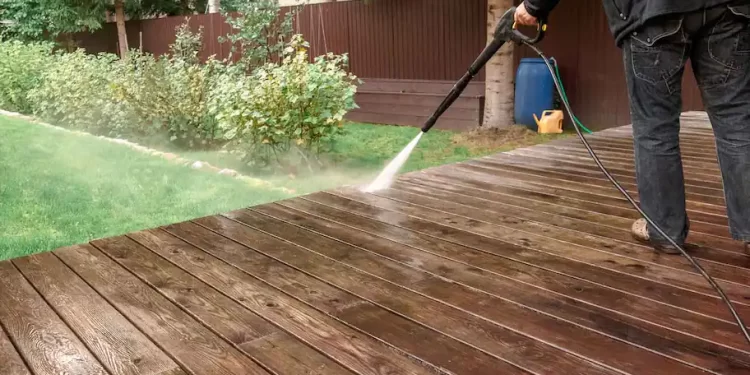Power washing patios is a transformative maintenance task that not only revitalizes the appearance of outdoor living spaces but also helps to preserve the integrity of the materials beneath your feet. Whether you’re dealing with the aftermath of a harsh winter, the accumulation of algae and mildew, or simply the wear and tear of everyday use, power washing can restore your patio to its former glory. This guide embarks on a journey to explore the nuances of power washing various patio surfaces, from the rugged durability of concrete to the natural elegance of wood and stone. Understanding the correct approach for each material is key to not only achieving a clean surface but also ensuring the longevity and safety of your patio.
Introduction to Power Washing Patios
Power washing is more than just blasting water at high pressure; it’s a delicate dance of choosing the right equipment, detergents, and techniques to suit each unique surface. With the rise of DIY home improvement projects, homeowners are keen to take on the challenge themselves. However, the process can be daunting without a clear roadmap. This guide aims to demystify power washing, providing step-by-step instructions, safety precautions, and pro tips to empower even the most novice users to confidently clean their patios. By the end of this guide, readers will be equipped with the knowledge to not only tackle their current cleaning projects but also to maintain their patios in pristine condition for years to come, enhancing both the aesthetic and functional aspects of their outdoor spaces.
Understanding Power Washing Equipment
Power washing equipment is essential for effectively cleaning patio surfaces, and understanding the nuances of this equipment is the first step to achieving optimal results. Power washers vary greatly in terms of power, size, and functionality, making it crucial to select the right machine for your specific project.
Types of Power Washers
Power washers come in electric and gas-powered models. Electric power washers are quieter, lighter, and suitable for light to medium cleaning tasks, such as washing cars, outdoor furniture, and patios made of delicate materials. Gas-powered models, on the other hand, offer more power and mobility, making them ideal for tackling larger, more stubborn cleaning jobs on surfaces like concrete and stone.
Pressure Settings and Nozzles
The pressure output of power washers is measured in pounds per square inch (PSI). Higher PSI levels mean more power for removing tough stains and debris, but they also increase the risk of damaging softer surfaces. Choosing the right pressure setting and nozzle is critical. Nozzles are color-coded based on the angle of the water stream they produce, ranging from a narrow, high-pressure jet for intense cleaning to a wider, softer spray for delicate surfaces.
Red nozzle (0 degrees): Produces a concentrated and powerful jet of water, best used for removing heavy dirt and stains from hard surfaces.
Yellow nozzle (15 degrees): Offers a slightly wider angle, suitable for general cleaning on concrete and hard surfaces.
Green nozzle (25 degrees): Provides a balance between cleaning power and surface safety, ideal for most patio surfaces.
White nozzle (40 degrees): Delivers a wider, gentler spray, perfect for delicate surfaces and rinsing.
Eco-friendly Detergents
In addition to mechanical action, detergents play a crucial role in breaking down tough stains, algae, and mildew. Opting for eco-friendly detergents ensures that your cleaning process is not only effective but also safe for the environment, your plants, and the surfaces you’re cleaning.
Understanding the capabilities and limitations of your power washing equipment is foundational to executing a successful cleaning project. The right combination of power washer, pressure setting, nozzle, and detergent allows you to tackle any patio cleaning task with confidence, ensuring that you achieve the best possible results without causing damage to your outdoor space.
Preparing Your Patio for Power Washing
Proper preparation is essential for a successful power washing project. Taking the time to prepare your patio not only ensures a smoother cleaning process but also protects your property and landscaping from potential damage. Here’s how to get ready for your patio power washing
Clearing the Area
Begin by removing all furniture, grills, planters, and decorations from the patio. This not only provides unobstructed access to the surface but also protects your belongings from water and cleaning solutions. If there are large or heavy items that are difficult to move, cover them with waterproof tarps or plastic sheeting.
Protecting Surrounding Areas
Next, take a moment to protect the surrounding areas. Close windows and doors near the patio to prevent water and debris from entering your home. Cover delicate plants, flowers, and landscaping features with tarps or plastic sheeting to shield them from high-pressure water and detergents. It’s also wise to note the location of electrical outlets and fixtures to avoid direct water contact.
Sweeping and Inspection
Sweep the patio to remove loose debris, leaves, and dirt. This not only makes the power washing process more effective but also prevents clogs in your power washer’s nozzle. After sweeping, inspect the patio for cracks, chips, or any damage. Identifying these areas beforehand allows you to adjust your cleaning technique to prevent exacerbating the damage.
Choosing the Right Time
Timing can significantly impact the effectiveness of your power washing project. Opt for a cool, overcast day to prevent the quick evaporation of water and cleaning solutions, which can result in uneven cleaning and water spots. Additionally, avoid windy days to prevent spray and detergents from affecting unintended areas.
Pre-Treatment
For patios with significant staining, mold, or mildew, applying a pre-treatment solution before power washing can be beneficial. Use an eco-friendly detergent recommended for your patio’s material, applying it with a sprayer or a soft brush. Allow the solution to sit for a while (as recommended on the product label) to break down tough stains and make the power washing process more efficient.
By thoroughly preparing your patio for power washing, you not only ensure a more effective cleaning but also protect your property and landscaping from potential damage. This preparatory phase sets the stage for a successful and efficient cleaning process, allowing you to achieve the best possible results with your power washing project.
Techniques for Power Washing Concrete Patios
Concrete patios are popular due to their durability and low maintenance, but over time, they can accumulate dirt, grime, and stains, diminishing their appearance. Power washing can restore the look of a concrete patio, but it requires specific techniques to avoid damage and ensure a thorough clean.
Selecting the Right Pressure
For concrete surfaces, a pressure washer with a PSI rating between 3000 to 4000 is generally effective. This range is powerful enough to remove most stains and build-up without damaging the concrete. If your patio is relatively new or in good condition, starting with a lower pressure and gradually increasing as needed can help prevent etching or pitting.
Choosing the Correct Nozzle
A rotary or turbo nozzle is often recommended for concrete because it combines high pressure with a rotating spray, effectively dislodging dirt and grime without staying in one spot too long, which could damage the surface. For less severe stains or for general cleaning, a 15-degree yellow nozzle can provide a good balance between cleaning power and surface safety.
Cleaning Technique
Begin cleaning by dividing the patio into manageable sections. This helps ensure even cleaning and prevents missing spots. Start at one end, holding the nozzle about 12 inches from the surface, and use a steady, sweeping motion to clean. Overlap each pass slightly to avoid streaks. For stubborn stains, you may need to move closer (but not closer than 6 inches) or apply a detergent designed for concrete and let it sit before rinsing.
Detergents and Stain Removal
For tough stains like oil, grease, or mildew, pre-treating the area with a concrete-compatible detergent can make a significant difference. Apply the detergent according to the manufacturer’s instructions, allowing it to penetrate the stain before power washing. Always ensure the detergent is eco-friendly and safe for use on concrete surfaces.
Post-Cleaning Care
After power washing, inspect the patio for any lingering stains or missed areas. If necessary, treat these areas with spot cleaning using a more direct spray or additional detergent. Once the patio is thoroughly cleaned, allow it to dry completely before replacing furniture and decorations. This is also an opportune time to seal the concrete if it hasn’t been done recently. Sealing not only protects the surface from future stains and weathering but can also enhance the appearance of the concrete.
Power washing a concrete patio, when done correctly, can significantly improve its appearance and extend its lifespan. By selecting the right equipment, using the correct techniques, and taking care to protect the surface, homeowners can achieve professional-quality results and enjoy a refreshed outdoor space.















